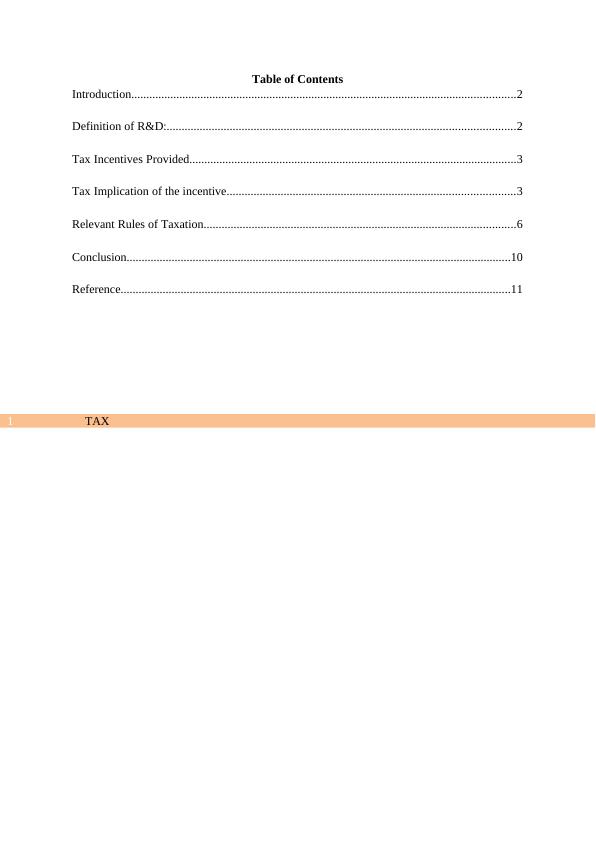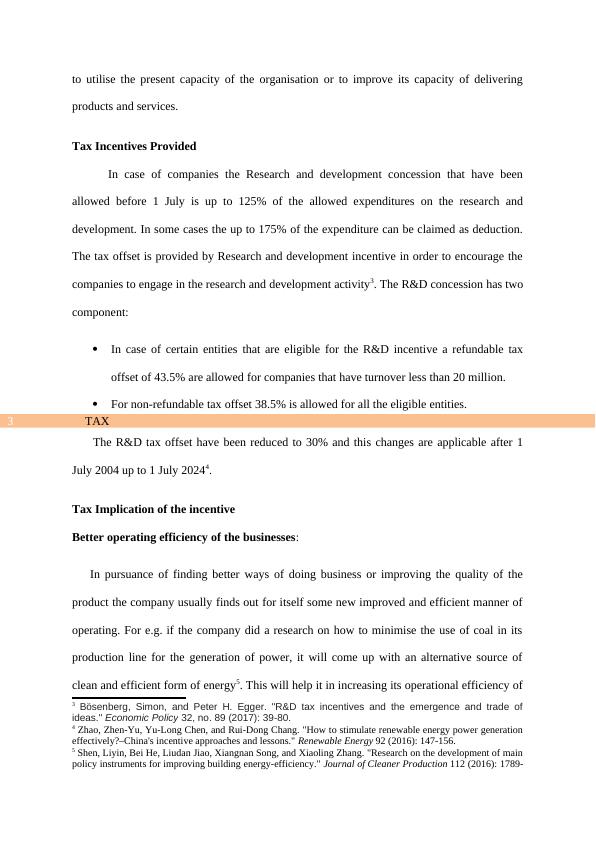TAX Tax Authorization
Added on 2020-05-28
14 Pages3001 Words293 Views
Running head: TAXTaxName of the Student:Name of the University:Authors Note:

TAX1Table of ContentsIntroduction................................................................................................................................2Definition of R&D:....................................................................................................................2Tax Incentives Provided.............................................................................................................3Tax Implication of the incentive................................................................................................3Relevant Rules of Taxation........................................................................................................6Conclusion................................................................................................................................10Reference..................................................................................................................................11

TAX2IntroductionOne of the factors that is going to ensure that an entity remains ahead of itscompetition in the market in pursuance of carrying out the business operation, is that theentity is adapting to the changes taking place in the market be it in terms of new technologyor methodology in carrying out the business activities. Research and development activitieswithin the organisation help it to develop and implement new ways or products in itsproduction method or line of products respectively. It ensures that the company maintains acompetitive edge over its competitors1. The development of new products or technologies bythe business entities not only proves to be beneficial for them but also for the entire society aswell. For e.g. if automobile industry develops vehicles which run entirely on electricity, itwill not only help the companies to earn more revenue but the society will be able to reducethe usage of fossil fuel thereby reducing the carbon footprint and improving the quality ofenvironment. Thus, in order to promote research and development activities by the companiesthe statute gives many tax incentives in respect of expenditure incurred in this behalf. Theseincentives are being categorised as R&D incentives. The document is focussed on discussionabout the various tax incentives offered by the statute and the conditions that need to befulfilled in order to avail them. Definition of R&D:The activities conducted under the tag of Research and Development are investigativein nature. They are the efforts made by an enterprise to improve its current products andservices or to develop a new kind of product or service that will enable it to deliver betterquality or retain its present quality but with improved way of production2. It as an endeavour1 Taylor, Grantley, and Grant Richardson. "Incentives for corporate tax planning and reporting: Empiricalevidence from Australia."Journal of Contemporary Accounting & Economics10, no. 1 (2014): 1-15.2De Silva, P. N. K., S. J. R. Simons, and P. Stevens. "Economic impact analysis of natural gasdevelopment and the policy implications."Energy Policy88 (2016): 639-651.

TAX3to utilise the present capacity of the organisation or to improve its capacity of deliveringproducts and services. Tax Incentives ProvidedIn case of companies the Research and development concession that have beenallowed before 1 July is up to 125% of the allowed expenditures on the research anddevelopment. In some cases the up to 175% of the expenditure can be claimed as deduction.The tax offset is provided by Research and development incentive in order to encourage thecompanies to engage in the research and development activity3. The R&D concession has twocomponent:In case of certain entities that are eligible for the R&D incentive a refundable taxoffset of 43.5% are allowed for companies that have turnover less than 20 million.For non-refundable tax offset 38.5% is allowed for all the eligible entities. The R&D tax offset have been reduced to 30% and this changes are applicable after 1July 2004 up to 1 July 20244. Tax Implication of the incentiveBetter operating efficiency of the businesses:In pursuance of finding better ways of doing business or improving the quality of theproduct the company usually finds out for itself some new improved and efficient manner ofoperating. For e.g. if the company did a research on how to minimise the use of coal in itsproduction line for the generation of power, it will come up with an alternative source ofclean and efficient form of energy5. This will help it in increasing its operational efficiency of3Bösenberg, Simon, and Peter H. Egger. "R&D tax incentives and the emergence and trade ofideas."Economic Policy32, no. 89 (2017): 39-80.4 Zhao, Zhen-Yu, Yu-Long Chen, and Rui-Dong Chang. "How to stimulate renewable energy power generationeffectively?–China's incentive approaches and lessons."Renewable Energy92 (2016): 147-156.5 Shen, Liyin, Bei He, Liudan Jiao, Xiangnan Song, and Xiaoling Zhang. "Research on the development of mainpolicy instruments for improving building energy-efficiency."Journal of Cleaner Production112 (2016): 1789-

End of preview
Want to access all the pages? Upload your documents or become a member.
Related Documents
BLO2206 Taxation Law Assignment- Tax Incentivelg...
|12
|2935
|34
Tax Implications of the Incentiveslg...
|11
|2812
|31
R&D Tax Incentives for Small Business in Australialg...
|7
|2748
|110
Assignment - Australian Taxation Lawlg...
|12
|2594
|97
The Research and Development Tax Incentiveslg...
|10
|2766
|292
The Implication of R&D Incentives Application to Small Business in Australialg...
|9
|3751
|286
